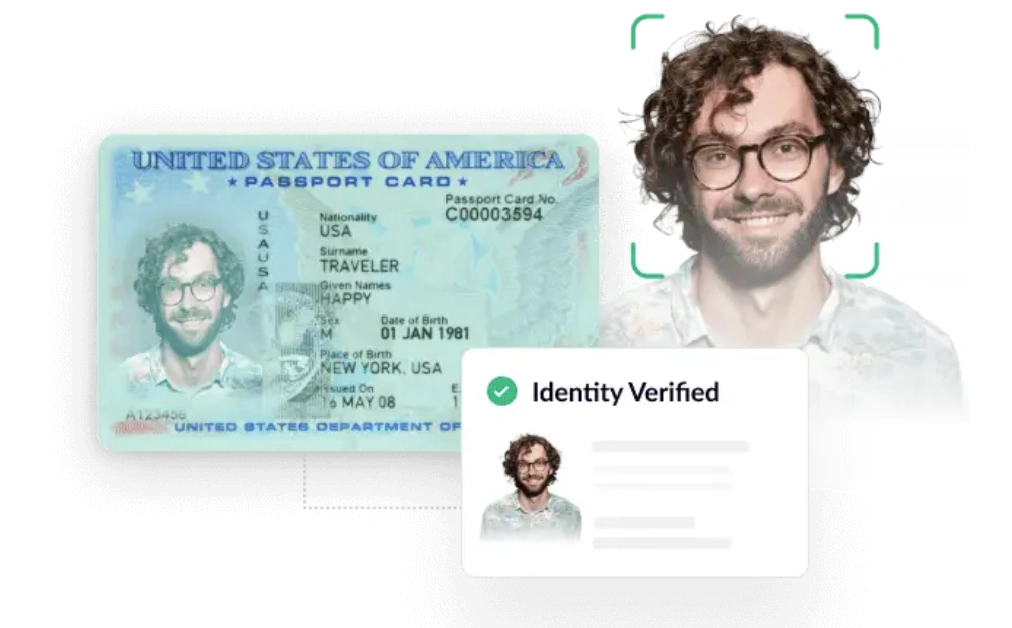Last year, when the Bank of Thailand mandated facial recognition for account holders, their banking system got hacked. GoldDigger, a trojan Android app developed by Chinese hackers, made deepfake videos of their customers to access accounts.
What does this incident tell you?
As high-tech as it seems, facial recognition is also vulnerable to threats like spoofing attacks. The good news is, liveness detection is a potential savior of this looming threat. It is an advanced computer algorithm that detects the authenticity of biometrics like facial recognition. Like in active liveness detection, the person sitting in front of the camera has to perform certain actions like moving their head or smiling to prove they are a live person.
Understanding liveness detection
Liveness detection perfectly fits your existing identity verification process. Here’s how it makes a difference:
The importance of liveness detection in identity verification process
Identity verification process confirms a person’s identity by comparing their personal information with official documents like a driving license or passport copy. For example, while opening a bank account, the bank must have asked you to upload your photo to compare it with the picture on your ID as a part of their digital identity verification process.
Facial recognition is a significant step in authenticating a user’s face in identity verification. But, liveness testing builds an extra net of safety on top of that. It asks users to record a video so that it can detect the liveness of the person’s face in real-time. So if fraudsters get access to someone else’s photo, they cannot access the account because they will be busted during liveness detection.
Passive vs. Active liveness detection technology
There are two types of liveness detection: Passive liveness detection and Active liveness detection. Here’s how they are different:
Passive detection gets its name from the passive nature of the technology. It uses AI and advanced computer vision technology to analyze the texture of the skin, facial movements, and other cues to identify real human characteristics.
How is it different from active liveness detection?
User involvement: Passive liveness asks users to click a photo or record a video and sit back. It does rest of the work in the background silently. Active detection prompts the user to perform certain actions to evaluate their authenticity

Technique: Active liveness testing uses a challenge-response technique to check the live input of the user. Passive liveness testing uses natural indicators to analyze the biometrics.
The mechanics of active liveness detection
If you’re curious to discover how active liveness detection works, here’s a quick summary of its mechanics:
How active liveness detection works
Active liveness detection runs on two wheels: Computer vision algorithms and 3-D cameras. The role of the algorithm is to detect natural human movements like turning heads, smiling face, or voice commands. The 3D cameras assess the depth and dimension of the face to identify facial expressions and differentiate a real human face from a silicon mask for example.
Powering these wheels is the machine learning model engine. These models are trained on datasets of both live and spoof biometrics. It keeps learning and adapting itself to newer threats by recognizing spoof attack attempts.
Overcoming challenges in active liveness detection
Active liveness check is a remarkable development in facial recognition technology. It attempts to prevent spoofing attacks by overcoming two advanced security threats – Replay attacks and Deepfakes
Replay attacks: These kinds of attacks occur when a hacker deciphers an in-transit encrypted data exchanged between two parties. The hacker then uses the same data to impersonate the real user and get unauthorized access to personal information. For example, using a pre-recorded smiling video of a user for a facial recognition scan. These attacks are mitigated with active liveness detection by asking the user to perform actions in real-time. If someone is using a pre-recorded video, it will get flagged in this case and an attack will be averted.

Deep fakes: Deep fakes are more complicated compared to replay attacks. An AI algorithm is trained to identify similar characteristics in the face an original user with another random person’s face. The algorithm then reconstructs the face which looks like the original user. So when you watch a deepfake video, you cannot find out if it’s the original user or a fake representation. The same happens with the biometric authentication system. Unless there is active liveness detection, the biometric verification cannot identify a deepfake video.
Benefits of active liveness detection
There are two areas where an active liveness check will make a seismic shift in your current biometric systems:
Enhanced security
Hackers are constantly upgrading themselves to breach private data and use it to their advantage. Active liveness detection protects your identity verification process by securing the precious data of your customers and avoiding spoofing and presentation attacks.
Improved user experience
It might feel like you are asking your users to do extra work for security purposes. But they are aware that such practices are in place to keep their account information safe from fraudsters. Moreover, you can improve the user experience by getting a tight grip on the authentication process. The biggest dividend of having this is the trust that you will build over time with your users.
Real-World applications of active liveness detection
Active liveness detection will play different roles in different industries. Here are the top three sectors where we expect to see the maximum application:
Financial services
Banks and financial institutions are probably the best examples of how active liveness detection can be useful in preventing fraud. As online transactions and payments are becoming more popular, customers are more vulnerable to attacks. Active liveness is a great liveness detector to prevent presentation attacks.
Government and border control
Immigration security is another sensitive area that can be bolstered with active liveness detection. It will avoid identity theft and forgery of government-issued official documents.
Other industries
Active liveness detection will significantly improve security in the healthcare industry to protect sensitive user health records. In the retail industry, live facial tests at the time of purchase or making transactions at marketplaces will prevent fraudsters from getting credit card information. Lastly, it will also give a significant boost to the access control industry to develop more advanced systems for biometric authentication.
The future of active liveness detection
Active liveness detection is advancing at a breakneck speed:
Advancements in technology
With the advancement in AI and machine learning, the active liveness detection process will detect liveness quickly and more accurately. Companies have also started using blockchain technology to store encrypted biometric data of their users to further make it challenging for users to access customer information.
Conclusion
The fast advancement in technology is making things easier and more accessible for people. But, on the flip side, it is also making personal information more vulnerable to phishing attacks. Biometric authentication can be tricked with replay attacks and deepfake videos. Active liveness detection holds the key to an advanced level security of security based on user interaction in real time.
For companies, it will be a challenge to balance a high level of security and uninterrupted user experience. They need a trusted partner like HyperVerge that uses high-end technology and gives more preference to frictionless experience to the users.
Ready to take the next step? Learn more about HyperVerge’s real-time face detection technology.
FAQs
1. What is active liveness detection?
Active liveness detection shares instructions with users to record a video and perform actions in real time like smiling or turning their head to prove they are a real person. It’s an advanced facial recognition technology that does not get easily fooled by fraudsters.
2. What is the difference between active and passive liveness?
Active liveness detection depends on the user interaction to analyze the authenticity of the person sitting in front of the camera. Passive liveness detection uses advanced computer vision techniques to analyze the skin texture and facial movements of a person. It doesn’t require any interaction from the user.
3. What is an example of liveness detection?
Recording a video with a smiling face while opening a bank account is an example of liveness detection.
4. What are the different types of liveness detection?
Active liveness detection and Passive liveness detection are the two types of liveness detection.

 US
US
 IN
IN








